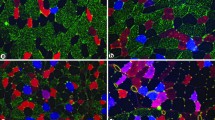Abstract.
The individual structural stages in capillary growth have been identified during development and under pathological circumstances in adults (wound healing, tumors), but there are no data to indicate whether these steps are similar when angiogenesis is induced in a fully differentiated microvascular bed in normal, uninjured adult skeletal muscle. In this study changes in capillary ultrastructure were correlated with capillary density and network morphology to elucidate the sequelae of angiogenesis in adult rat extensor digitorum longus (EDL) muscle whose activity was increased by stimulation at 10 Hz (8 h/day). This resulted in an increased capillary/fiber (C/F) ratio (based on staining for alkaline phosphatase) after 4 days; by 7 days C/F ratio was increased further, by approximately 50%. The ultrastructure of capillary endothelium in both the EDL and extensor hallucis proprius (EHP) was similar to control muscles after 2 days of stimulation, whereas endothelial cells in some capillaries in muscle stimulated for 4 days revealed signs of metabolic activation such as proliferation of organelles (Golgi apparatus, endoplasmic reticulum, ribosomes and mitochondria) and fewer pinocytic vesicles. Luminal surfaces were often irregular with numerous pseudopodial processes. Basement membranes were always present but amorphous regions were observed, particularly near pericyte processes. Unusually small capillary profiles, with either a slit-like lumen or with cisternae but no lumen, probably represented capillary sprouts. The interstitium contained increased collagenous and granular extracellular matrix surrounding capillaries, and numerous activated fibroblasts which were closely apposed to many capillaries. Capillary growth in EHP was also evaluated by confocal microscopy using whole mounts. The complex pattern of vessels underwent remodelling between 2 and 7 days of stimulation, resulting in more tortuous capillaries with numerous sprouts and loops. These combined observations suggest that angiogenesis may occur by a combination of sprouting, intussusceptive growth and elongation; also, that activation of endothelial cells occurs at the same time as disturbance of basement membranes during the earliest phase of growth and remodelling of the capillary bed. These changes are postulated to occur in connection with increased shear stress and/or capillary wall tension, which have been demonstrated previously.
Similar content being viewed by others
Author information
Authors and Affiliations
Additional information
Received: 6 March 1996 / Accepted: 8 May 1996
Rights and permissions
About this article
Cite this article
Hansen-Smith, F., Hudlicka, O. & Egginton, S. In vivo angiogenesis in adult rat skeletal muscle: early changes in capillary network architecture and ultrastructure. Cell Tissue Res 286, 123–136 (1996). https://doi.org/10.1007/s004410050681
Issue Date:
DOI: https://doi.org/10.1007/s004410050681




